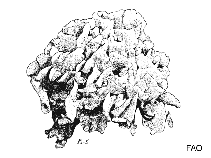Agaricia grahamae Wells, 1973
Graham's sheet coralWarning: DOMDocument::load(): SSL operation failed with code 1. OpenSSL Error messages: error:140770FC:SSL routines:SSL23_GET_SERVER_HELLO:unknown protocol in C:\Apache24\htdocs\includes\SpeciesSummary.lib.php on line 1236
Warning: DOMDocument::load(): Failed to enable crypto in C:\Apache24\htdocs\includes\SpeciesSummary.lib.php on line 1236
Warning: DOMDocument::load(https://sealifebase.nrm.se/webservice/AquaMaps/getAMap.php?genus=Agaricia&species=grahamae): failed to open stream: operation failed in C:\Apache24\htdocs\includes\SpeciesSummary.lib.php on line 1236
Warning: DOMDocument::load(): I/O warning : failed to load external entity "https://sealifebase.nrm.se/webservice/AquaMaps/getAMap.php?genus=Agaricia&species=grahamae" in C:\Apache24\htdocs\includes\SpeciesSummary.lib.php on line 1236
Uploaden van je Foto's
Google afbeelding | No image available for this species;
drawing shows typical species in Agariciidae.
Google afbeelding | No image available for this species;
drawing shows typical species in Agariciidae.
Classification / Names Common names | Synonyms | CoL | ITIS | WoRMS
| Scleractinia | Agariciidae
Environment: milieu / climate zone / depth range / distribution range Ecologie
; diepteverspreiding 0 - 119 m (Ref. 847). Tropical; 24°N - 25°S, 91°W - 31°W (Ref. 847)
Verspreiding Landen | FAO regio's | Ecosystems | Voorkomen | Introducties
Western Atlantic: Caribbean Sea and East Brazil Self.
Length at first maturity / Size / Gewicht / Leeftijd
Maturity: Lm ? range ? - ? cm
Korte beschrijving Morfologie
Colonies form flat unifacial explanate plates which are commonly arranged in whorls. Corallites are at the bottom of long, roughly concentric V-shaped valleys. Centers are widely spaced. Septa are thick, do not alternate, and most reach the corallite center. Tan or grey in color, usually with pale margins.
Maximum depth from Ref. 124095.
Life cycle and mating behavior Geslachtsrijpheid | Voortplanting | Kuitschieten | Eieren | Fecundity | Larven
Members of the class Anthozoa are either gonochoric or hermaphroditic. Mature gametes are shed into the coelenteron and spawned through the mouth. Life cycle: The zygote develops into a planktonic planula larva. Metamorphosis begins with early morphogenesis of tentacles, septa and pharynx before larval settlement on the aboral end.
Voornaamste referentie
Referenties | Coördinator | Medewerkers
Bisby, F.A., M.A. Ruggiero, K.L. Wilson, M. Cachuela-Palacio, S.W. Kimani, Y.R. Roskov, A. Soulier-Perkins and J. van Hertum. 2005. (Ref. 19)
Status op de Rode Lijst van het IUCN (Ref. 130435)
Bijna bedreigd (NT) ; Date assessed: 01 June 2021
Status bij CITES (Ref. 108899)
Appendix II: International trade monitored
CMS (Ref. 116361)
Not Evaluated
Gevaarlijk voor mensen
Gebruik door de mens
| FishSource |
Tools
Meer informatie
Populaire namen
Synoniemen
Predators
Voortplanting
Geslachtsrijpheid
Kuitschieten
Fecundity
Eieren
Ontwikkeling van de eieren
Synoniemen
Predators
Voortplanting
Geslachtsrijpheid
Kuitschieten
Fecundity
Eieren
Ontwikkeling van de eieren
Internet-bronnen
BHL | BOLD Systems | CISTI | DiscoverLife | FAO(Publication : search) | Fishipedia | GenBank (genoom, nucleotide) | GloBI | Gomexsi | Google Books | Google Scholar | Google | PubMed | Hexacorallians of the World | Tree of Life | Wikipedia (ga naar, zoek) | Zoological Record
Estimates based on models
Preferred temperature
(Ref. 115969): 27.2 - 28.1, mean 27.7 (based on 90 cells).
Prijsklasse
(Ref. 80766):
Unknown.



